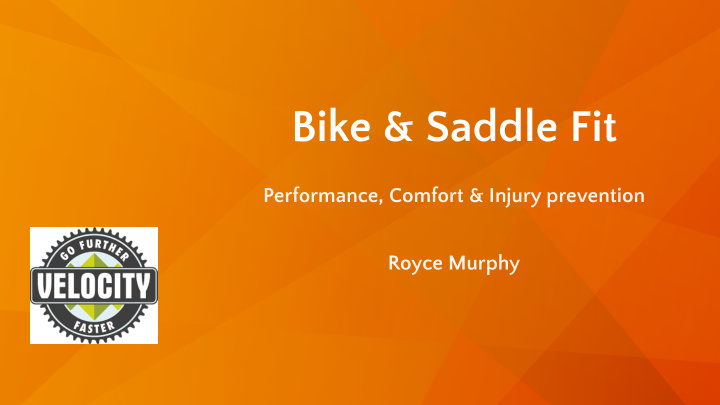



Bike & Saddle Fit Performance, Comfort & Injury prevention Royce Murphy
What matters most? • Comfort • Performance Objectives for a bike fit • Injury prevention Fit bike to rider and/or Fit rider to bike? Is there one position to rule them all? • Rider’s objectives & priorities • Injury history • Any current problems • Their flexibility & other limitations Physical assessment • Unassisted leg raise • Hip hinge • Knee bend with heel on floor • Press-up
Review rider’s history & objectives Physical assessment Feet • Cleats (fore/aft, rotation, in/out) Process & • Shoe design (curved or straight last) • Arch support (defaut = flat foot) Degrees of Freedom Goal = good knee tracking & no knee or foot pain Seat • Saddle position (height + fore/aft) • Crank length (shorter is better) • Saddle design (shape, padding, pressure relief, etc.) Goal = Support for pedal stroke & no pain in soft tissues Hands • Stem (length, angle, spacers) • Handlebar shape (reach & drop) • Handlebar width (versus clavicle width) Goal = Straight wrists, relaxed arms & no neck/shoulder pain Iteration
Feet 3 degrees of freedom with cleats - why? Knee tracking Work for • Cleats match your natural foot rotation & ball of foot • Shoes match a curved or straight foot shape • Linear knee tracking • Support your arch - if needed • Stretching & microfacial release
Your position on the saddle Why do saddles have “wings”? Can you match the image to the “pressure map”? If you’re too far forward, what happens? • Bones go off the edges of the saddle • Pressure shifts onto soft tissues • Lose support for your pedal stroke ○ Shifts work onto your core muscles You should be able to see the saddle nose while riding!
Saddle Level • Why does it matter? • Is there one method to check all saddles? Saddle position on • Check manufacturer’s website for guide the bike Saddle Fore/Aft Position • Why does it matter? • Knee over pedal axle Saddle Height • Why does it matter? • Is there one “best” height? • Heel on pedal method ○ Set bike on turbo ○ Heels on pedals ○ Pedal backward ○ Full leg extension, but ○ No rocking of hips
Hands & Upper Body Is it just reach, drop & bar width? How can you avoid numb hands, stiff neck & sore back? Work for • Neutral wrists • Relaxed shoulders • “Soft elbows” • Hip hinge for neutral back • Stronger core (lower back & obliques)
Feet: Hips are generally wider (knees don’t stay over toe throughout pedal stroke) Female fit versus Male • Pedal spacers to widen stance • Cleat wedges or arch support for knee tracking fit? Seat: Bones at front of pelvis are wider & shorter (discomfort on the saddle) • Saddle width • Cut out or groove to relieve pressure on front • Torso angle more upright to reduce pressure at front Hands: Narrower shoulders & more joint mobility (soreness in neck or between shoulders) • Narrower handlebars (joint mobility) • Less handlebar reach & drop (shorter & higher stem)
Analysis & Workshop with Chris
Bike Fit by Phil Burt (British Cycling) Sources of more Strength & Conditioning for Cyclists by information Phil Burt and Martin Evans BikeDynamics.co.uk www.slipstreamers.co.uk/2015/08/royc es-bike-fit-session-18th-april/ Royce@velocitysportscycling.com
Feet • Cleats (fore/aft, rotation, in/out) Process & • Shoe design (curved or straight last) • Arch support (defaut = flat foot) Degrees of Freedom Goal = good knee tracking & no knee or foot pain Bum • Saddle position (height + fore/aft) • Crank length (shorter is better) • Saddle design (shape, padding, pressure relief, etc.) Goal = Support for pedal stroke & no pain in soft tissues Hands • Stem (length, angle, spacers) • Handlebar shape (reach & drop) • Handlebar width (versus clavicle width) Goal = Straight wrists, relaxed arms & no neck/shoulder pain
Recommend
More recommend